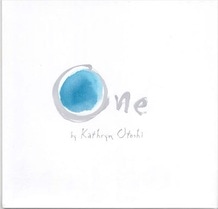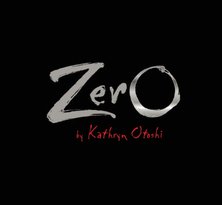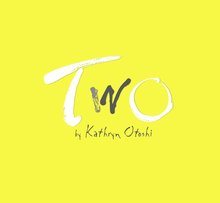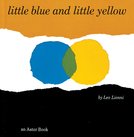and is currently working at The Codman Academy Public Charter School in Dorchester.
Writers write what they know and experience, and so for this Forum, I have decided I to write about something I have recently experienced in my librarian life at Codman Academy. I have had some unexpected reactions to the books I have been sharing with my students … abstract picture books that have proven to be real hits!

While Otoshi’s books are often considered concept books, I feel they are so much more. In One, each of the concrete colors becomes a number with a personality that the young reader needs to recognize, without a human form. Otoshi does this skillfully by assigning characteristics to the colors (Red is a “hot head”, “Blue is a quiet color”, “sunny like Yellow”, “bright Green”, “regal Purple” and “outgoing Orange”. etc.). Feelings are universal and this makes them transcend the basic concepts of color and numbers. Red picks on Blue - “Red is hot and Blue is not.” This makes Blue feel bad about himself. While the other colors try and make Blue feel better, they never say anything in front of Red, which only makes Red grow bigger and bigger until he is so big everyone is afraid of him. The simple abstract watercolor illustrations on these pages show Red filling the page as the other colors deflate in size. The accompanying text has a clear voice. When One comes into the picture, he is strong silver metallic color, standing as tall as Red. He turns to the colors and says, “If someone is mean and picks on me, I, for One will stand up and say, ‘No’.” Influenced by One, the other colors all become numbers, beginning with Yellow, who now feels brave and says, ‘Me Two!’” Then all the colors assume a number shape in order to stand up and count. Green becomes Three, Purple becomes Four, and Orange becomes Five.
Blue sees the colors change, and also wants to COUNT. Red grows red-hot feeling left out. When he tries again to pick on Blue, “this time Blue stood up tall and became 6. Red can be really HOT … but Blue can count.” With this, Red starts to deflate, and Blue calls out, “Can Red be hot, AND Blue be cool?” This causes Red to stop in his tracks and listen. “Red can count, too”, says One. Then Red rocked and rolled and turned into … SEVEN!”
This abstract book on bullying adds more than just illustrating the act of bullying, it provides a real solution in how to stop it! Standing up to a bully isn’t easy, but the character of One stands tall and provides both an example and support to the others, as well as providing the words they can use. One is a leader and as he gains respect from the colors, they want to follow him. That leaves Red, the bully, all alone. But the resolution to this problem of bullying goes further than most books on the subject. It gives the bully a way to be change and save face. He ultimately becomes part of the group, turning around his negativity and becoming whole. The text on the last page of the book, encircling the number One, reads, “It only takes One.” This is a powerful message that generated wonderful discussion with my students.

Since One was such a hit, I read Zero by Kathryn Otoshi (San Rafael, CA.: KO Kids Books, 2010) to my students. This book is a continuation of One, where now the numbers help Zero find its value. Again, I found my students (who are often wiggly and distracted) fixed on the images, words, and voices of the characters. It helps to read with different voices when there are multiple characters, keeping the characters straight, and adding to the drama. But what I was really interested in was this idea of abstract images having personality and a voice in dealing with difficult social topics such as bullying, inclusion, conflict resolution, and identity. They were helping the children find their voice and providing the words to help themselves in these situations.
Zero sees herself as an empty hole. “How could a number worth nothing be something?” She compares herself to One who is “solid and strong with bold strokes and squared corners” while Zero is “big and round with no corners at all.” The other numbers help her by suggesting she change her shape so she can count, too. “But Zero could only be Zero.” She tries several things to make herself more important. “It’s no use trying”, sobbed Zero. “I’ll never have value. I’ll never be part of the count.” Then red Seven, the bully from the previous book points out, “It’s what’s inside that counts most.” Zero looks at herself and responds, “ But…what if I don’t have anything inside?” To this, Seven says, “Every number has value. Be open. You’ll find a way.” Zero then sees “herself in a new light.” “I’m not empty inside. I’m open!” Zero rolls up to the numbers and announces that she’s found a way for all the numbers to count more! Zero jumps and leaps and joins the numbers as 10, 20, 30, 40, 50, 60, 70… “And what’s next? 100! 1,000! 10, 000! 100,000! 1,000,000! ‘We do count more!’” they cheered. And this time when Zero “looked at herself, she felt whole… right in her center.”
Not only is this book a positive lesson in finding identity and self-worth, it is instructive as a math book. Kindergartners and first graders recognized the patterns the numbers made, and the older students recognized how zero influenced place value.

Zero becomes the leader in this story and rushes over to Two. “The numbers are dividing!” When Two asks what she can do, she says, “Half of me doesn’t care about that odd pair. Maybe it’s time for me to be done with One?” Zero tells Two that she should look at the bigger problem, not just the smaller side that only affects her. “The Evens and Odds are in a fight. What if you can make things right? Can you find it in your heart to see, a new angle to this possibly?” Two pulls herself together and tells all the numbers, “It’s not easy to say, but I’ve come to see, it’s tricky to dance when there are three. One should have other friends – and the same goes for me.” Three apologizes to Two “playing the odds wasn’t fair to you.” All the numbers then join in dancing together in different pairs. “It’s fun to dance with everyone!” the numbers say. When Two bumps into One, she apologizes and One softly asks, “Hey, Two. Can I still count on you?” Two responds, “It’s the end and guess what? We’re still friends.” Otoshi does it again, providing conflict resolution with integrity for both sides and a powerful example for students without being moralizing or didactic. The text is clear, sometimes poetic, and adds to the story providing pacing and movement. Her illustrations are simple effective water-colored numbers on a white background, as are all her books in this series.


I have found these books fascinating to read with the children in my inner city school. My students seem to be more focused and intent on the words, as if the abstract images trigger feelings and ideas within themselves, instead of being passive when all the details are drawn out for them. There is more of a synergy of reader and book. I feel these abstract images get important messages across without being preachy or moralistic and perhaps because there are no recognizable faces to the characters speaking, children are more inclined to listen.
I would be very interested if any of you librarians/teachers have experienced this as well, or not. I welcome your feedback, especially if you have experienced similar reactions to these books by your students. I’m also interested if you have any other titles to add to this discussion. These books are very popular with my students. I even had to go to the public library to get copies of some of the books in order to write this because my library’s copies were out!

